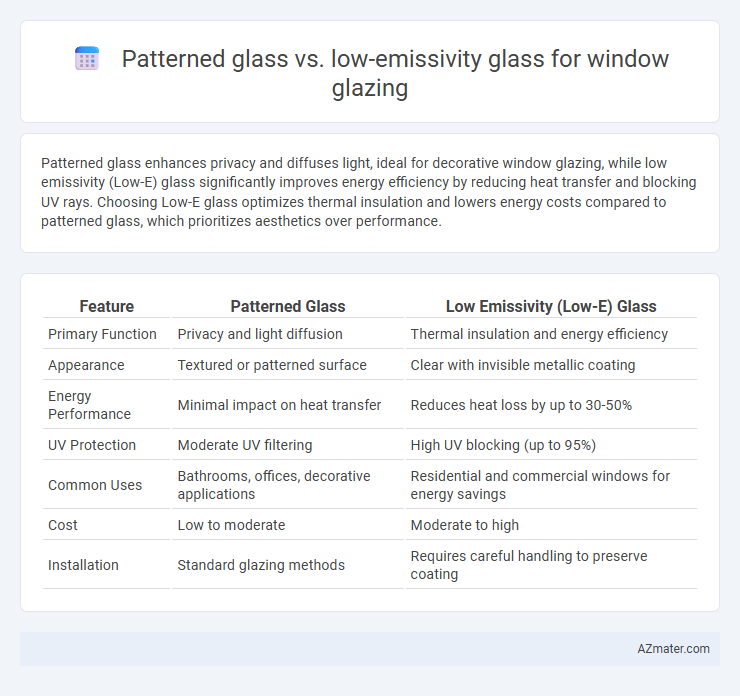Patterned glass enhances privacy and diffuses light, ideal for decorative window glazing, while low emissivity (Low-E) glass significantly improves energy efficiency by reducing heat transfer and blocking UV rays. Choosing Low-E glass optimizes thermal insulation and lowers energy costs compared to patterned glass, which prioritizes aesthetics over performance.
Table of Comparison
| Feature | Patterned Glass | Low Emissivity (Low-E) Glass |
|---|---|---|
| Primary Function | Privacy and light diffusion | Thermal insulation and energy efficiency |
| Appearance | Textured or patterned surface | Clear with invisible metallic coating |
| Energy Performance | Minimal impact on heat transfer | Reduces heat loss by up to 30-50% |
| UV Protection | Moderate UV filtering | High UV blocking (up to 95%) |
| Common Uses | Bathrooms, offices, decorative applications | Residential and commercial windows for energy savings |
| Cost | Low to moderate | Moderate to high |
| Installation | Standard glazing methods | Requires careful handling to preserve coating |
Introduction to Window Glazing Solutions
Patterned glass and low emissivity (Low-E) glass serve distinct purposes in window glazing solutions, enhancing both aesthetics and energy efficiency. Patterned glass offers privacy and decorative appeal by diffusing light through textured surfaces, making it ideal for bathrooms and offices. Low-E glass minimizes heat transfer by reflecting infrared energy, significantly improving insulation and reducing energy costs in residential and commercial buildings.
What is Patterned Glass?
Patterned glass features textured surfaces that enhance privacy and diffuse natural light while maintaining illumination, making it ideal for decorative and functional window glazing. Unlike smooth glass types, patterned glass minimizes visibility without compromising brightness, often used in bathrooms, office partitions, and entrance doors. This glass type differs from low emissivity (Low-E) glass, which is engineered with microscopically thin coatings to reduce infrared and ultraviolet light transfer, improving energy efficiency and thermal insulation in windows.
What is Low Emissivity (Low-E) Glass?
Low Emissivity (Low-E) glass features a microscopically thin coating that minimizes the amount of infrared and ultraviolet light passing through while allowing visible light to enter, enhancing energy efficiency. Unlike patterned glass, which primarily offers decorative effects and privacy, Low-E glass improves thermal insulation by reflecting heat back into the room during winter and blocking heat in summer. This makes Low-E glass ideal for window glazing applications aimed at reducing energy costs and increasing indoor comfort.
Visual Appearance: Patterned vs Low-E Glass
Patterned glass features textured designs that enhance privacy and obscure visibility while allowing natural light to pass through, making it ideal for decorative or privacy-focused applications. Low emissivity (Low-E) glass is typically clear with a thin metallic coating that minimizes infrared and ultraviolet light, preserving visibility and maintaining natural daylight without the obscured appearance. Visually, patterned glass provides distinct textures and patterns, whereas Low-E glass maintains a smooth, transparent surface optimized for energy efficiency without altering the window's clarity.
Energy Efficiency Comparison
Low emissivity (Low-E) glass significantly outperforms patterned glass in energy efficiency by reducing heat transfer and minimizing ultraviolet and infrared light penetration through window glazing. Patterned glass primarily offers aesthetic privacy benefits without notable thermal insulation properties, resulting in higher energy loss compared to Low-E glass. Windows equipped with Low-E coatings contribute to lower heating and cooling costs by maintaining indoor temperature stability, crucial for sustainable energy consumption.
Light Transmission and Privacy
Patterned glass offers moderate light transmission while enhancing privacy through textured surfaces that obscure visibility, making it ideal for spaces requiring diffused natural light without compromising privacy. Low emissivity (Low-E) glass provides high light transmission with superior thermal insulation by reflecting infrared rays, but it typically lacks the privacy benefits of patterned glass due to its clear and smooth surface. Selecting between patterned and Low-E glass depends on prioritizing either privacy and diffused light or energy efficiency and maximum natural light penetration.
Thermal Insulation Properties
Patterned glass offers moderate thermal insulation by diffusing sunlight and reducing glare but lacks advanced energy efficiency features. Low emissivity (Low-E) glass significantly enhances thermal insulation by reflecting infrared heat back into the room while allowing visible light to pass through, reducing heat loss in winter and heat gain in summer. The superior thermal performance of Low-E glass makes it a preferred choice for energy-efficient window glazing compared to patterned glass.
Cost Considerations
Patterned glass generally offers a lower upfront cost compared to Low Emissivity (Low-E) glass, making it a budget-friendly option for decorative or privacy-focused window glazing. Low-E glass incorporates a microscopically thin coating that improves energy efficiency by reducing heat transfer, which can justify its higher initial price through long-term savings on heating and cooling costs. When evaluating cost considerations, factoring in potential energy savings and durability often makes Low-E glass a more economical choice over time despite its premium price.
Applications and Best Uses
Patterned glass is ideal for privacy applications in bathrooms, offices, and decorative partitions due to its textured surfaces that obscure visibility while allowing natural light. Low emissivity (Low-E) glass excels in energy-efficient window glazing, reflecting infrared heat to maintain indoor temperature and reduce energy costs, making it perfect for residential and commercial buildings in varying climates. Combining patterned glass with Low-E coatings offers both aesthetic privacy and thermal performance, enhancing comfort in spaces requiring both features.
Choosing the Right Glass for Your Windows
Patterned glass offers decorative privacy by diffusing light while obscuring visibility, making it ideal for bathrooms and entryways. Low emissivity (Low-E) glass enhances energy efficiency by reflecting infrared heat, reducing heat loss in winter and heat gain in summer, which is crucial for maintaining indoor comfort and lowering energy bills. Selecting between patterned and Low-E glass depends on priorities: choose patterned glass for aesthetics and privacy, or Low-E glass for superior thermal performance in window glazing.

Infographic: Patterned glass vs Low emissivity glass for Window glazing
 azmater.com
azmater.com